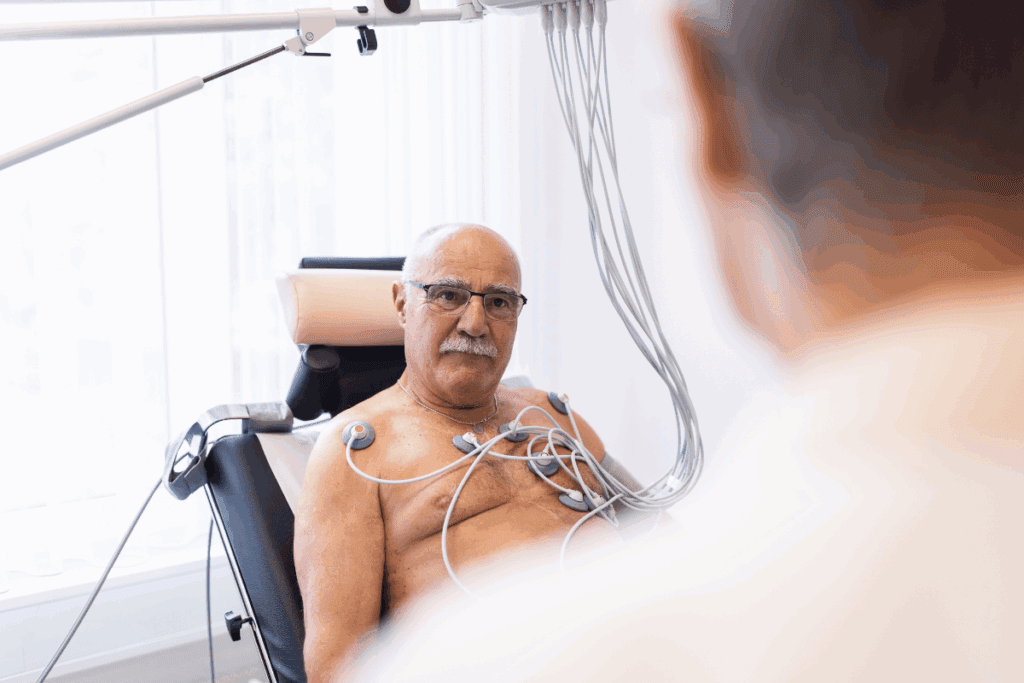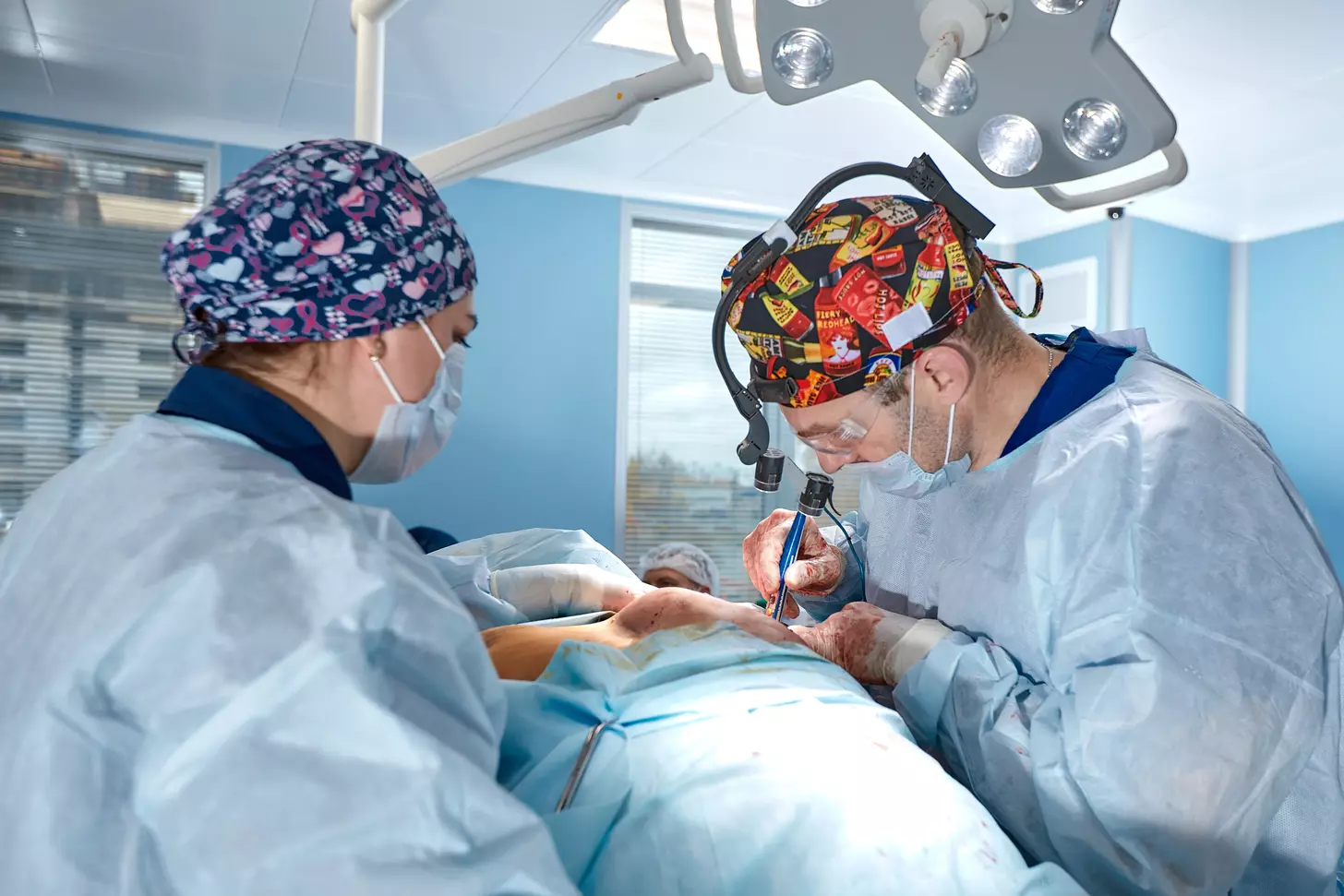Last Updated on November 26, 2025 by Bilal Hasdemir
Cardiac catheterization, or cardiac cath, is a procedure that helps diagnose and treat heart issues. It involves placing a stent to keep the artery open. This improves blood flow to the heart.
At Liv Hospital, we focus on patient trust and safety by using the latest protocols to ensure quality in every cardiac cath. Understanding how long does a cardiac cath with stents take can help ease your concerns and prepare you for what’s ahead. Typically, the procedure itself takes about 30 minutes to an hour, but the total time at the hospital, including preparation and recovery, can be several hours depending on the complexity. This comprehensive approach ensures you receive the best care throughout the process.

The time it takes for cardiac catheterization can vary. But, if it’s just for diagnosis, it usually takes about 30 minutes. But, getting ready and recovering adds several hours to your stay at the hospital.
Key Takeaways
- Cardiac cath is a minimally invasive procedure for diagnosing and treating heart conditions.
- Stent placement helps keep the artery open, improving blood flow to the heart.
- Liv Hospital follows international quality standards for cardiac cath procedures.
- The procedure duration varies, but diagnostic cardiac cath typically takes about 30 minutes.
- Preparation and recovery add several hours to the total hospital stay.
Understanding Cardiac Catheterization and Stent Placement
Cardiac catheterization and stent placement are key in cardiology today. They offer a way to diagnose and treat heart issues without big surgery. These methods are vital for fighting coronary artery disease, a big cause of illness and death worldwide.
What is a Cardiac Catheterization?
A cardiac catheterization, or heart cath, is a procedure. It involves putting a thin, flexible tube into an artery in the leg or arm. Then, it’s guided to the heart. This lets doctors see the heart’s inner workings and fix problems.
Doctors use contrast dye to see the heart’s arteries on an X-ray. This shows if there are blockages. The whole thing happens in a special lab with a team of experts.
Types of Stents and Their Functions
Stents are small, mesh-like tubes used after an angioplasty. They keep the arteries open. There are different stents, each with its own benefits.
| Type of Stent | Description | Function |
| Bare-metal Stents | Made of metal mesh | Provides structural support to keep the artery open |
| Drug-eluting Stents | Coated with medication | Reduces the risk of restenosis by releasing medication that prevents cell proliferation |
| Bioresorbable Stents | Made of absorbable material | Provides temporary support and then dissolves, potentially reducing long-term complications |
The right stent depends on the patient’s health, the blockage’s location and size, and the doctor’s advice.
Common Reasons for Undergoing This Procedure
People get cardiac catheterization and stent placement for many reasons. Mainly, it’s to deal with coronary artery disease. Reasons include:
- Chest pain or angina
- Abnormal stress test results
- Acute coronary syndrome or heart attack
- Blocked or narrowed coronary arteries
The global market for implantable medical devices, like stents, is growing fast. This is because more people have heart disease and new tech is coming out. The market size was USD 97.55 billion in 2024 and is expected to hit around USD 179.70 billion by 2034.

Knowing about cardiac catheterization and stent placement helps patients get ready for these procedures. It shows how important they are for heart health.
Preparing for Your Cardiac Catheterization
To make your cardiac cath experience as seamless as possible, we guide you through the necessary preparations.
Pre-Procedure Testing and Evaluation
Before your cardiac catheterization, your healthcare team will conduct several tests. These tests include blood tests, electrocardiograms (ECGs), and chest X-rays. It’s important to follow your doctor’s instructions regarding any necessary testing to avoid delays.
The testing phase is vital for assessing your overall health and identifying any risks. Your medical team will review your test results to tailor the procedure to your specific needs.
Dietary and Medication Restrictions
Dietary adjustments are often necessary before a cardiac cath. You may be required to fast for a certain period, usually starting at midnight before the procedure. It’s also important to inform your doctor about any medications you’re taking, including blood thinners, as these may need to be adjusted or temporarily stopped.
| Medication Type | Action Required | Timing |
| Blood Thinners | Stop or adjust dosage | As directed by your doctor |
| Diabetes Medications | Adjust dosage | Usually the day before |
| Other Medications | Continue as usual unless directed to stop | – |
Mental and Emotional Preparation
Preparing mentally and emotionally for your cardiac cath is just as important as the physical preparations. Discussing your concerns with your healthcare provider or a counselor can be very helpful. Understanding the procedure and its benefits can also reduce anxiety.
Consider having a friend or family member accompany you to the hospital for support. Knowing what to expect can make a significant difference in your overall experience.

What to Bring to the Hospital
To ensure a smooth hospital visit, it’s essential to come prepared. Bring:
- Your insurance cards and identification
- A list of your current medications
- Comfortable clothing to change into after the procedure
- Any personal items that may help you relax, such as a book or music
By being well-prepared, you can focus on your recovery and the steps ahead.
The Day of Your Procedure: What to Expect
On the day of your cardiac catheterization, you’ll go through a series of steps. We know this day can be both important and worrying. So, we’re here to help you through every step.
Arrival and Initial Preparation
When you arrive at the hospital, you’ll go to the cath lab’s waiting area. Our staff will welcome you and start getting you ready. You’ll change into a hospital gown and lie on a special table for the procedure.
Pre-procedure checks will confirm your identity and the procedure. You’ll also review your medical history. An IV line will be started for medications and fluids.
Meeting Your Medical Team
Before starting, you’ll meet the team doing your procedure. This includes an interventional cardiologist, nurses, and technicians. They’re all very experienced.
They’ll explain the procedure in detail. They’ll answer your questions and talk about what to expect during and after.
Pre-Procedure Monitoring and Setup
We’ll attach monitors to track your heart rate, blood pressure, and oxygen levels. This monitoring is important for your safety during the procedure.
The cath lab has advanced imaging technology. This lets us see your heart’s anatomy in real-time. It’s key for the success of your procedure.
Total Hospital Stay Timeline (5-9 Hours)
The procedure itself takes about 30-60 minutes. But, you’ll spend around 5-9 hours at the hospital. This depends on the procedure’s complexity and your recovery.
| Activity | Estimated Time |
| Registration and Preparation | 1-2 hours |
| Cardiac Catheterization Procedure | 30-60 minutes |
| Recovery Time | 2-4 hours |
| Total Hospital Stay | 5-9 hours |
Knowing this timeline helps you plan your day. It also helps with arrangements for care after you leave.
How Long Does a Cardiac Cath With Stents Take: Timeline Breakdown
The time it takes for a cardiac catheterization with stent placement can change. This depends on several factors. We will look at the typical time for diagnostic catheterization and the extra time for angioplasty and stent placement.
Diagnostic Catheterization Duration
A diagnostic catheterization usually lasts about 30 minutes. During this time, the cardiologist uses a catheter to reach the heart. They use imaging to see the coronary arteries.
Additional Time for Angioplasty and Stent Placement
If angioplasty and stent placement are needed, the procedure can take longer. It can add 1-2 hours or more. This extra time is for widening the artery with a balloon and placing a stent.
A report on the global Interventional Cardiology Devices Market says procedure time can increase. This is because procedures are getting more complex.
“The complexity of coronary artery disease and the need for precise stent placement can significantly impact the overall procedure time.”
Factors That May Extend Procedure Time
Several things can make the procedure take longer. These include:
- The complexity of the blockage
- The number of stents required
- The presence of other health conditions
- Any complications that arise during the procedure
Waiting for the procedure can be stressful. Knowing these factors can help manage expectations.
| Procedure Component | Typical Duration |
| Diagnostic Catheterization | 30 minutes |
| Angioplasty and Stent Placement | 1-2+ hours |
| Total Procedure Time | 1.5-2.5+ hours |
Understanding what affects the time of a cardiac cath with stents helps. Patients can prepare better for the procedure and recovery.
Step-by-Step Through the Procedure
Learning about cardiac catheterization can help reduce anxiety for those going through it. We’ll walk you through each step, from getting ready to the final stent placement.
Catheter Insertion and Navigation
The first step is putting in the catheter. This is done through an artery in the groin or arm. Local anesthesia is used to numb the area, making it less painful. The catheter is then guided through the blood vessels to the heart with the help of advanced imaging.
The cardiologist must be precise in navigating the catheter through the vascular system. This is done under X-ray monitoring, allowing the team to see the catheter’s path.
Diagnostic Imaging Process
With the catheter in place, the next step is diagnostic imaging. A contrast dye is injected to see the coronary arteries on an X-ray. The cardiologist can then spot any blockages or issues in the arterial walls.
This imaging is key for figuring out the extent of any heart disease and planning the best treatment. New imaging tech has made this process more accurate and safe.
Angioplasty Technique
If a blockage is found, an angioplasty might be done to widen the artery. A small balloon on the catheter is inflated to push aside the plaque and stretch the wall. The angioplasty technique is controlled to avoid harming the artery.
In some cases, other treatments like atherectomy might be used along with angioplasty to get the best results.
Stent Deployment Process
After angioplasty, a stent is usually placed to keep the artery open. The stent deployment process involves placing a small, mesh-like tube (the stent) at the blockage site. The stent is mounted on the balloon catheter and expanded when in place, keeping the artery open.
New stent tech, like drug-eluting stents, has improved outcomes. These advancements help lower the risk of artery narrowing and improve long-term results.
Knowing these steps can help patients prepare better for the cardiac cath procedure. It can also make them feel more confident in the care they’re receiving.
Immediate Post-Procedure Recovery Period
After a cardiac catheterization with stent placement, patients start a critical recovery phase. This phase needs careful monitoring and following specific guidelines. It’s key for the procedure’s success and the patient’s health.
Recovery Room Monitoring
Patients go to the recovery room after the procedure. They are watched for 2 to 6 hours. Medical staff check vital signs and look for any complications.
Activity Restrictions While in Hospital
In the hospital, patients should avoid hard work. This means no heavy lifting, bending, or intense exercise. It helps the body heal and lowers the risk of bleeding.
Discharge Criteria and Timing
When the patient is stable and shows no big problems, they can leave the hospital. Most leave a few hours after the procedure. They must meet certain criteria, like:
- Stable vital signs
- No signs of complications
- Can take care of themselves at home
- Have a grown-up to take them home
Transportation Arrangements
Patients should not drive themselves home. Make sure someone responsible will take them. This is because of sedation effects and the need for rest.
The Asia Pacific area is expected to grow the fastest. This is because of more heart diseases and more healthcare spending. Proper care after the procedure is very important. It helps patients recover well and stay healthy long-term.
| Recovery Aspect | Guidelines |
| Monitoring | Close observation in the recovery room for 2-6 hours |
| Activity | Avoid strenuous activities, heavy lifting, and bending |
| Discharge | When stable, with no complications, and with a responsible adult to accompany them home |
| Transportation | Do not drive; arrange for a responsible adult to transport them home |
“The key to a successful recovery lies in the careful monitoring and adherence to post-procedure guidelines. By understanding what to expect and following the instructions provided by healthcare professionals, patients can minimize risks and ensure a smooth recovery.”
At-Home Recovery Timeline and Guidelines
After you get home from your procedure, knowing the recovery timeline is key. Your recovery at home is as important as the care you got in the hospital.
First 24-48 Hours After Discharge
The first 24-48 hours are very important. Rest and avoid hard activities. Keep the insertion site clean and dry, and watch for any infection signs.
- Rest and avoid heavy lifting or bending.
- Keep the insertion site clean and dry.
- Monitor for signs of infection or complications.
First Week Recovery Milestones
In the first week, you’ll start to feel better slowly. It’s normal to feel some fatigue, but you can do light activities. Here’s what to expect:
| Day | Expected Milestones |
| 1-2 | Rest and minimal activity |
| 3-4 | Gradually increase activity level |
| 5-7 | Resume light activities, avoid heavy lifting |
When to Resume Normal Activities
Going back to normal activities should be slow. Check with your healthcare provider before driving, going back to work, or doing hard activities.
- Avoid driving until your doctor advises it’s safe.
- Gradually return to work as advised by your healthcare provider.
- Resume strenuous activities only when cleared by your doctor.
Medication Management
Managing your medications is very important during recovery. Adhere to the medication regimen your doctor gives you, and know about possible side effects.
By following these guidelines and keeping in touch with your healthcare provider, you can have a successful recovery at home.
Benefits and Risks of Cardiac Catheterization with Stents
It’s important for patients to know the benefits and risks of cardiac catheterization with stents. This procedure has changed how we treat heart disease. It’s a complex method that has made a big difference.
Immediate and Long-term Benefits
Cardiac catheterization with stents has many benefits. Immediate benefits include diagnosing and treating heart disease in one go. This means fewer procedures are needed. Long-term, it improves blood flow to the heart, reduces angina symptoms, and lowers the risk of heart attacks.
Recent advancements, like biocompatible materials and new techniques, have made the procedure safer and more effective. This has led to better results and faster recovery times, as reported by Nova One Advisor.
Common Minor Side Effects
While generally safe, cardiac catheterization with stents can cause minor side effects. These include:
- Bruising or discomfort at the catheter insertion site
- Mild allergic reactions to the contrast dye used during the procedure
- Temporary changes in kidney function
Most of these side effects are short-lived and go away on their own. But, it’s key to follow the post-procedure instructions carefully to avoid risks.
Rare but Serious Complications
Though rare, serious complications can happen. These include:
- Bleeding or hematoma at the catheter site
- Stroke or heart attack during or after the procedure
- Allergic reactions to the stent material
- Infection at the catheter site
It’s important for patients to know about these risks and talk to their healthcare provider about any concerns.
When to Seek Emergency Care
After the procedure, seek immediate medical help if you experience:
- Severe chest pain or discomfort
- Shortness of breath
- Weakness or numbness in the arms or legs
- Signs of infection at the catheter site, such as redness, swelling, or drainage
Knowing these warning signs can help you get the medical help you need quickly if complications happen.
Conclusion: What to Remember About Cardiac Catheterization and Stent Procedures
Cardiac catheterization with stent placement is a big step in heart health care. It’s a safe and effective way to treat heart issues. The whole process, from start to finish, uses the latest in heart care technology.
This procedure usually takes a few hours. The stent part is quick. Knowing what to expect helps patients prepare for a good outcome.
The market for heart care devices is growing fast. This is thanks to new tech and more people wanting less invasive treatments. Cardiac catheterization with stents is a key treatment for many. We hope this summary helps you understand its role in keeping hearts healthy.
FAQ
How long does a cardiac cath with stents take?
A cardiac cath with stents can take different times. It can be as short as 30 minutes for a simple test. But, it can take over 2 hours for more complex procedures like angioplasty and stent placement.
What is the typical hospital stay for a cardiac cath procedure?
You usually stay in the hospital for 5 to 9 hours after a cardiac cath procedure. This depends on how complex the procedure was and your health.
How long does it take to recover from a cardiac catheterization?
Recovery from a cardiac catheterization takes a few days to a week. You’ll need to rest for 24-48 hours after the procedure. Then, you can start doing normal things again within a week.
What are the benefits of cardiac catheterization with stents?
Cardiac catheterization with stents can quickly relieve symptoms. It opens blocked arteries, improves blood flow, and lowers the risk of heart attack.
What are the risks associated with cardiac catheterization and stent placement?
Cardiac catheterization and stent placement are generally safe. But, there are risks like bleeding, infection, and rare but serious problems like heart attack or stroke.
How long does a diagnostic catheterization take?
A diagnostic catheterization usually takes about 30 minutes.
How long does angioplasty and stent placement add to the procedure?
Angioplasty and stent placement can add 1 to 2 hours or more to the procedure. This depends on how complex the case is.
What should I expect during the recovery period after a cardiac cath?
During recovery, you’ll be monitored for a few hours. Then, you’ll be discharged. You’ll be told to rest, avoid hard activities, and follow a medication plan.
When can I resume normal activities after a cardiac catheterization?
You can usually go back to normal activities within a week. But, this depends on your health and what your doctor says.
How long does it take for the catheter site to heal?
The catheter site heals in a few days. It’s important to follow your doctor’s advice on wound care and activity levels.
References
- Bangalore, S., et al. (2019). Outcomes with Drug-Eluting and Bare-Metal Stents: A Meta-Analysis of Randomized Trials. Journal of the American College of Cardiology, 73(11), 1397-1406. https://pubmed.ncbi.nlm.nih.gov/30879881/






